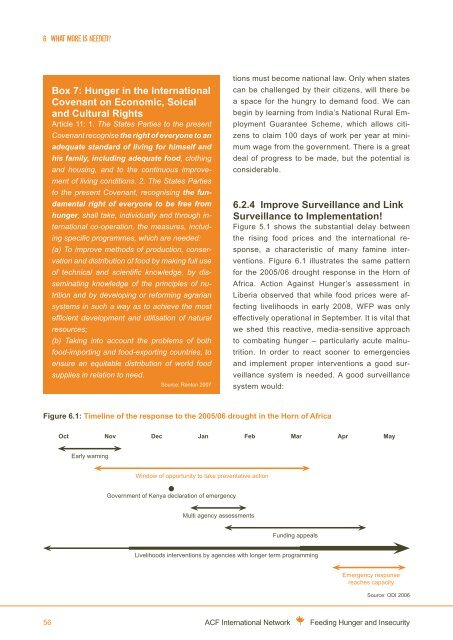Feeding hunger and insecurity
Feeding hunger and insecurity
Feeding hunger and insecurity
- No tags were found...
Create successful ePaper yourself
Turn your PDF publications into a flip-book with our unique Google optimized e-Paper software.
6. what more is needed?Box 7: Hunger in the InternationalCovenant on Economic, Soical<strong>and</strong> Cultural RightsArticle 11: 1. The States Parties to the presentCovenant recognise the right of everyone to anadequate st<strong>and</strong>ard of living for himself <strong>and</strong>his family, including adequate food, clothing<strong>and</strong> housing, <strong>and</strong> to the continuous improvementof living conditions. 2. The States Partiesto the present Covenant, recognising the fundamentalright of everyone to be free from<strong>hunger</strong>, shall take, individually <strong>and</strong> through internationalco-operation, the measures, includingspecific programmes, which are needed:(a) To improve methods of production, conservation<strong>and</strong> distribution of food by making full useof technical <strong>and</strong> scientific knowledge, by disseminatingknowledge of the principles of nutrition<strong>and</strong> by developing or reforming agrariansystems in such a way as to achieve the mostefficient development <strong>and</strong> utilisation of naturalresources;(b) Taking into account the problems of bothfood-importing <strong>and</strong> food-exporting countries, toensure an equitable distribution of world foodsupplies in relation to need.Source: Renton 2007tions must become national law. Only when statescan be challenged by their citizens, will there bea space for the hungry to dem<strong>and</strong> food. We canbegin by learning from India’s National Rural EmploymentGuarantee Scheme, which allows citizensto claim 100 days of work per year at minimumwage from the government. There is a greatdeal of progress to be made, but the potential isconsiderable.6.2.4 Improve Surveillance <strong>and</strong> LinkSurveillance to Implementation!Figure 5.1 shows the substantial delay betweenthe rising food prices <strong>and</strong> the international response,a characteristic of many famine interventions.Figure 6.1 illustrates the same patternfor the 2005/06 drought response in the Horn ofAfrica. Action Against Hunger’s assessment inLiberia observed that while food prices were affectinglivelihoods in early 2008, WFP was onlyeffectively operational in September. It is vital thatwe shed this reactive, media-sensitive approachto combating <strong>hunger</strong> – particularly acute malnutrition.In order to react sooner to emergencies<strong>and</strong> implement proper interventions a good surveillancesystem is needed. A good surveillancesystem would:Figure 6.1: Timeline of the response to the 2005/06 drought in the Horn of AfricaOct Nov DecJan Feb Mar Apr MayEarly warningWindow of opportunity to take preventative actionGovernment of Kenya declaration of emergencyMulti agency assessmentsFunding appealsLivelihoods interventions by agencies with longer term programmingEmergency responsereaches capacitySource: ODI 200656ACF International Network<strong>Feeding</strong> Hunger <strong>and</strong> Insecurity

















